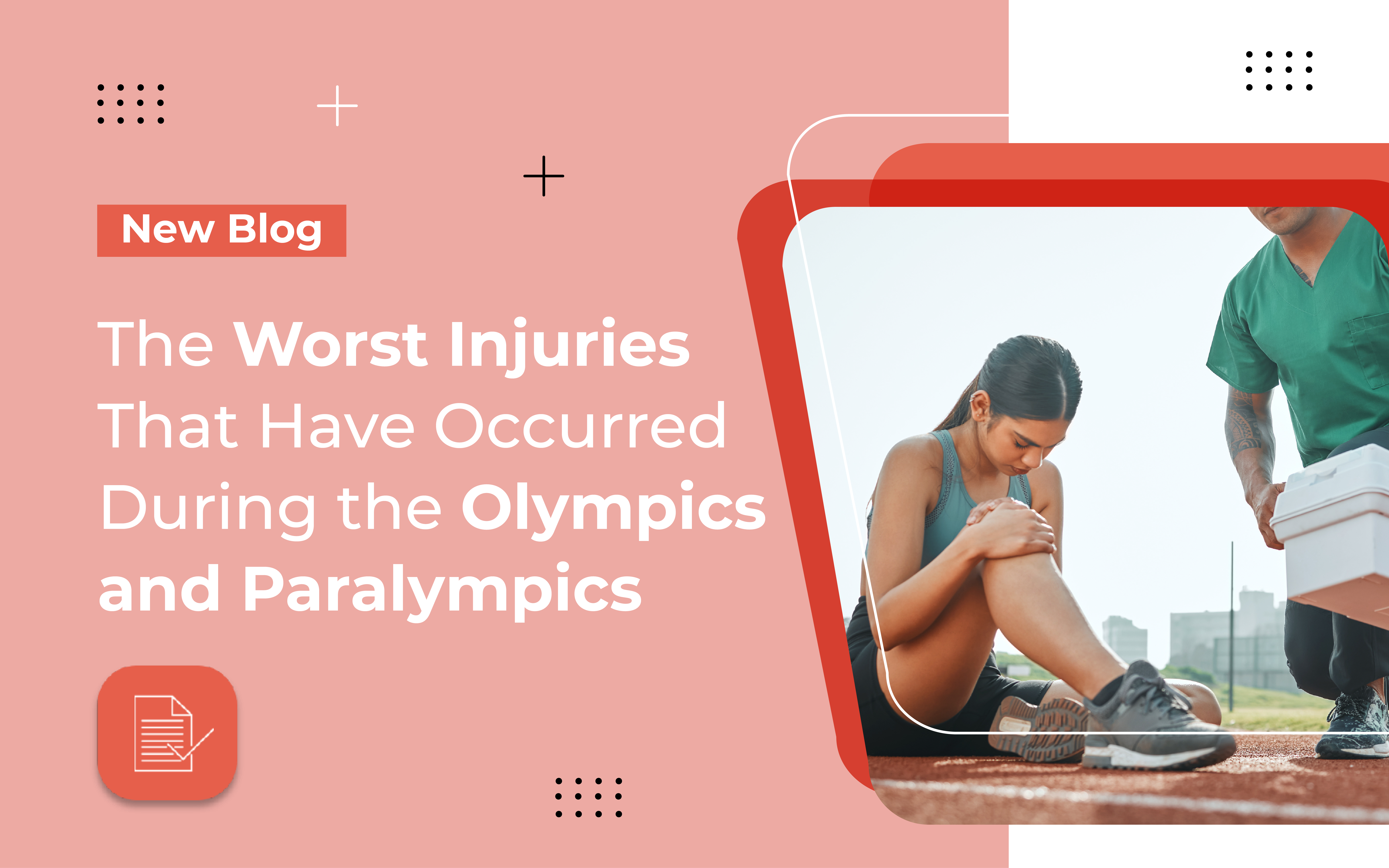
7 Aug 2024
The Worst Injuries That Have Occurred During the Olympics and Paralympics.
The Olympic and Paralympic Games are the pinnacle of athletic achievement, showcasing the best of human strength, speed and skill, however, the quest for glory often comes with significant risks.
Over the years, many athletes from around the world have suffered some harrowing injuries during these games, serving as sobering reminders of the dangers inherent in high-level competition. And here, we delve into some of the worst injuries that have occurred during the Olympics and Paralympics, exploring their causes, impacts and the resilience of the athletes involved.
-
Samir Ait Said - Gymnastics, Rio 2016
One of the most shocking injuries in Olympic history took place during the Rio 2016 Olympics, where French gymnast Samir Ait Said suffered a gruesome leg fracture during the men's vault qualification.
As he attempted a complex vault, he landed awkwardly, resulting in a double leg break, and the horrific scene was witnessed by spectators and broadcast worldwide, highlighting the extreme physical demands and dangers of gymnastics. And yet, despite this setback, Said's resilience shone through as he vowed to return to competition, inspiring many with his determination.
-
Nodar Kumaritashvili - Luge, Vancouver 2010
The 2010 Winter Olympics in Vancouver were marred by tragedy before the Games officially began, when Georgian luger Nodar Kumaritashvili lost control of his sled during a practice run, crashing at a high speed and suffering fatal injuries.
The accident raised serious questions about the safety of the luge track and led to immediate changes in the course's design and safety measures, with Kumaritashvili's death serving as a stark reminder of the lethal risks associated with winter sports and the importance of rigorous safety protocols.
-
János Faragó - Wrestling, Munich 1972
Hungarian wrestler János Faragó experienced a career-ending injury during the 1972 Munich Olympics whilst competing in a match where he suffered a severe spinal injury that left him paralysed from the waist down.
Faragó's injury underscored the dangers of contact sports, where the physicality and intensity can result in devastating consequences, and his story also highlights the need for comprehensive medical support and safety measures to protect athletes in high-risk sports.
-
Derek Redmond - Athletics, Barcelona 1992
In one of the most emotional moments in Olympic history, British sprinter Derek Redmond tore his hamstring during the 400 meters semi-final at the Barcelona 1992 Olympics, yet despite the excruciating pain, Redmond was determined to finish the race. And with the support of his father, who rushed onto the track to help, Redmond hobbled to the finish line, receiving a standing ovation from the crowd.
This incident, whilst not the most severe in terms of physical injury, became an enduring symbol of perseverance and the human spirit's indomitable nature.
-
Paige Greco - Cycling, Tokyo 2020 Paralympics
Australian Paralympian Paige Greco suffered a severe crash during a training session ahead of the Tokyo 2020 Paralympics, where she sustained significant injuries, including a broken collarbone and multiple fractures.
Despite these injuries, Greco's recovery and subsequent return to competitive cycling demonstrated incredible resilience and determination, though her story emphasises the unique challenges faced by Paralympians, who often contend with additional physical and mental hurdles.
-
Matthias Steiner - Weightlifting, Beijing 2008
German weightlifter Matthias Steiner experienced a terrifying accident during the 2008 Beijing Olympics where he attempted to lift 196 kg (432 lbs) in the clean and jerk, but subsequently lost control which led to the barbell falling on his neck, causing him to collapse.
Miraculously, he avoided serious injury and was able to walk away from the incident, but Steiner's brush with disaster underscores the extreme risks involved in weightlifting, where even a momentary lapse in concentration can lead to catastrophic injuries.
-
Kerri Strug - Gymnastics, Atlanta 1996
Kerri Strug's courageous performance at the 1996 Atlanta Olympics is legendary, whereby during the team gymnastics final, Strug injured her ankle on her first vault attempt, and yet despite the pain, she executed a second vault, securing the gold medal for Team USA.
Strug's injury was later diagnosed as a third-degree lateral sprain with tendon damage, though her determination to perform under such conditions has become an iconic moment in Olympic history, demonstrating the extraordinary commitment of athletes to their teams and their sport.
-
Lawrence Lemieux - Sailing, Seoul 1988
During the 1988 Seoul Olympics, Canadian sailor Lawrence Lemieux was in position to win a medal when he noticed a fellow competitor's boat had capsized and the sailors were in danger of drowning.
Without hesitation, Lemieux abandoned his race and went to their aid, saving their lives but sacrificing his chance for a medal. While not an injury to Lemieux himself, this incident highlighted the potential dangers in water sports and the extraordinary sportsmanship and bravery of athletes in the face of peril.
-
Greg Louganis - Diving, Seoul 1988
At the same 1988 Seoul Olympics, American diver Greg Louganis experienced a terrifying moment during the preliminaries of the men's 3-meter springboard event. As he attempted a dive, Louganis struck his head on the diving board, suffering a concussion and a deep cut that required stitches.
Remarkably, he went on to win gold in both the 3-meter springboard and the 10-meter platform events, though Louganis' recovery and triumph are testaments to his incredible skill and resilience, despite the dangers inherent in the sport of diving.
Lifelong injury support from Speed Medical
The injuries suffered by athletes during the Olympics and Paralympics are stark reminders of the intense physical demands and inherent risks of high-level sports, and all of these incidents highlight the importance of rigorous safety measures, proper training and immediate medical support to protect athletes.
However, whilst these injuries are all significant, the resilience and determination displayed by injured athletes often become inspirational stories, showcasing the human spirit's ability to overcome adversity.
As we celebrate the achievements of these remarkable individuals, we must also continue to prioritise their safety and well-being in every aspect of their training and competition.
The gold medal in service excellence
As the UK’s leading independent medical reporting agency and rehabilitation provider to the legal, healthcare and insurance industries, Speed Medical can work in partnership with you to deliver a flexible and convenient service to your clients and reduce administrative processes for your business.
That’s where we come in, with our team at Speed Medical on hand to support those with lifelong injury support during the times when they need it the most.
For over 25 years, we have developed and refined our skills, knowledge, IT infrastructure and supply chain co-ordination to build a strong reputation within the industry, now holding an impressive roster of eminent clients who will attest to our unequivocal commitment to customer service.
We also offer a truly bespoke service dedicated to support the complexity of a serious injury claim and the suite of investigative stages of a clinical negligence claim, and we offer a choice of nominated experts after assessing their relevant experience, qualifications, any conflict and ensuring service, giving you ultimate control over the most suitable expert for your case.




